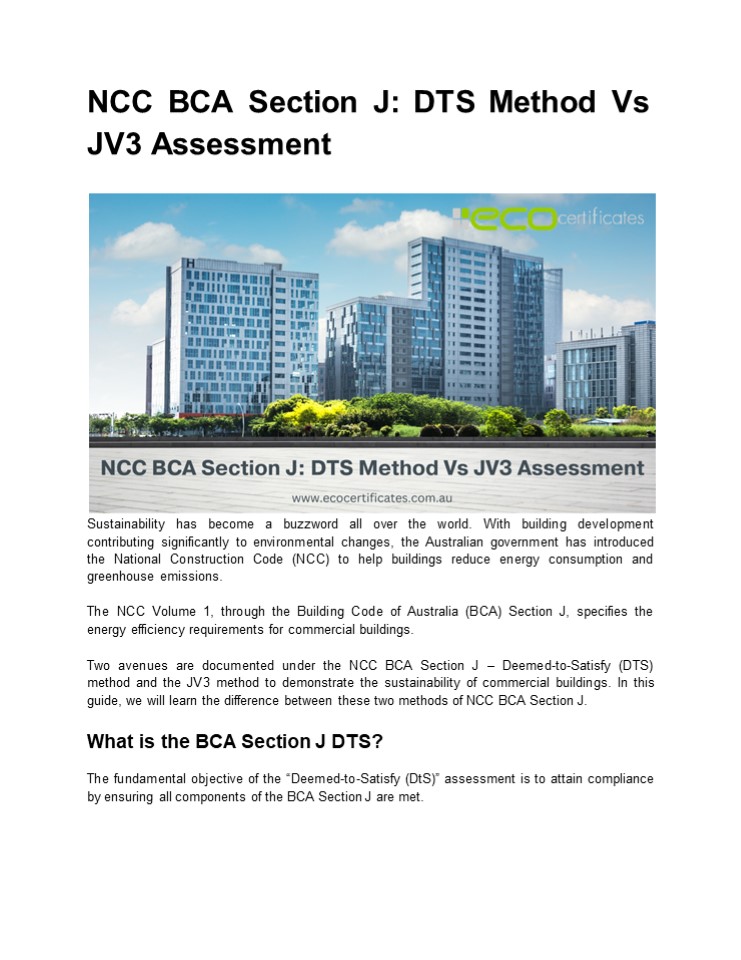NCC BCA Section J: DTS Method Vs JV3 Assessment - PowerPoint PPT Presentation
Title:
NCC BCA Section J: DTS Method Vs JV3 Assessment
Description:
Sustainability has become a buzzword all over the world. With building development contributing significantly to environmental changes, the Australian government has introduced the National Construction Code (NCC) to help buildings reduce energy consumption and greenhouse emissions. – PowerPoint PPT presentation
Number of Views:2
Title: NCC BCA Section J: DTS Method Vs JV3 Assessment
1
NCC BCA Section J DTS Method Vs JV3 Assessment
Sustainability has become a buzzword all over the
world. With building development contributing
significantly to environmental changes, the
Australian government has introduced the
National Construction Code (NCC) to help
buildings reduce energy consumption and
greenhouse emissions. The NCC Volume 1, through
the Building Code of Australia (BCA) Section J,
specifies the energy efficiency requirements for
commercial buildings. Two avenues are documented
under the NCC BCA Section J Deemed-to-Satisfy
(DTS) method and the JV3 method to demonstrate
the sustainability of commercial buildings. In
this guide, we will learn the difference between
these two methods of NCC BCA Section J. What is
the BCA Section J DTS? The fundamental objective
of the Deemed-to-Satisfy (DtS) assessment is to
attain compliance by ensuring all components of
the BCA Section J are met.
2
The components include prescriptive examples of
materials, design factors, products, and
construction and installation methods, which must
satisfy the performance requirements stated by
the NCC. These DTS requirements fall under the
NCCs nine main sections Part J0 Energy
Efficiency Part J1 Building Fabric Part J3
Building Sealing Part J5 Air conditioning and
ventilation (commonly known as HVAC) systems
Part J6 Artificial lighting and power Part J7
Heated water supply, spa pool, and swimming pool
plant Part J8 facilities for energy
monitoring Moreover, the DTS assessment process
for NCC BCA Section J compliance is dependent on
some additional factors, such as the building
class, the development of which falls under the
floor areas of different building zones and the
specific climate zones. Another point you should
know is the DTS provisions are generic and dont
consider the buildings geometry or unusual
conditions. A professional assessor recommends
deploying this form of assessment and reporting
where building development is simple and doesnt
involve significant design innovations. The
process is simple in terms of compilation
procedure and, thus, is a faster and economically
reasonable solution to assess whether the
building development complies with the NCC BCA
Section J. What is the JV3 Assessment? To comply
with the NCC Section J requirements, the NCC
introduced an alternate method to the DTS
approach, i.e., the JV3 Assessment
method. Implementing this approach, you can
include non-compliant provisions in a building
and still demonstrate the NCC Section J
compliance. Using this approach, you can ignore
the undesirable and expensive DTS requirements
and instead deploy effective and inexpensive
solutions to improve the overall performance and
economics of specific building development
projects. What is the Difference Between the BCA
Section J DTS and JV3 Method?
3
The requirements of each National Construction
Code (NCC) section are specified under various
sections of the Building Code of Australia (BCA)
in the form of Deemed to Satisfy (DTS)
requirements. The NCC BCA, Section J report,
must state that the specific building meets all
the applicable requirements of the BCAs
relevant parts to comply with the NCC
requirements. Aside from the DTS requirements of
the BCA, NCC also permits a performance-based
alternative solution to help demonstrate the
compliance of buildings with the requirements of
the pre-stated building code. To comply with
the NCCs section J, the JV3 assessment
formulates an alternative solution with
authorised computer modelling. Wrapping up it
all Most councils in Australia ask the building
owners to submit the NCC BCA Section J report as
a part of the documentation for the construction
certificate stage. The report explains the
requirements of the BCA Section J for the
specific building according to the national and
local area regulations. An expert consultant or
assessor will deploy the Section J DTS or JV3
assessment to study the design of the proposed
development to learn whether it meets specific
energy efficiency requirements. Therefore, both
BCA Section J DTS and JV3 assessment reports are
crucial to constructing energy-efficient,
sustainable buildings in Australia
4
Contact Us
Eco Certificates Website https//www.ecocertifica
tes.com.au Email ID info_at_ecocertificates.com.au A
ddress Suite G.03, 23 Ryde Road, Pymble NSW,
Australia- 2073 Phone Number 61 1300162436
.































